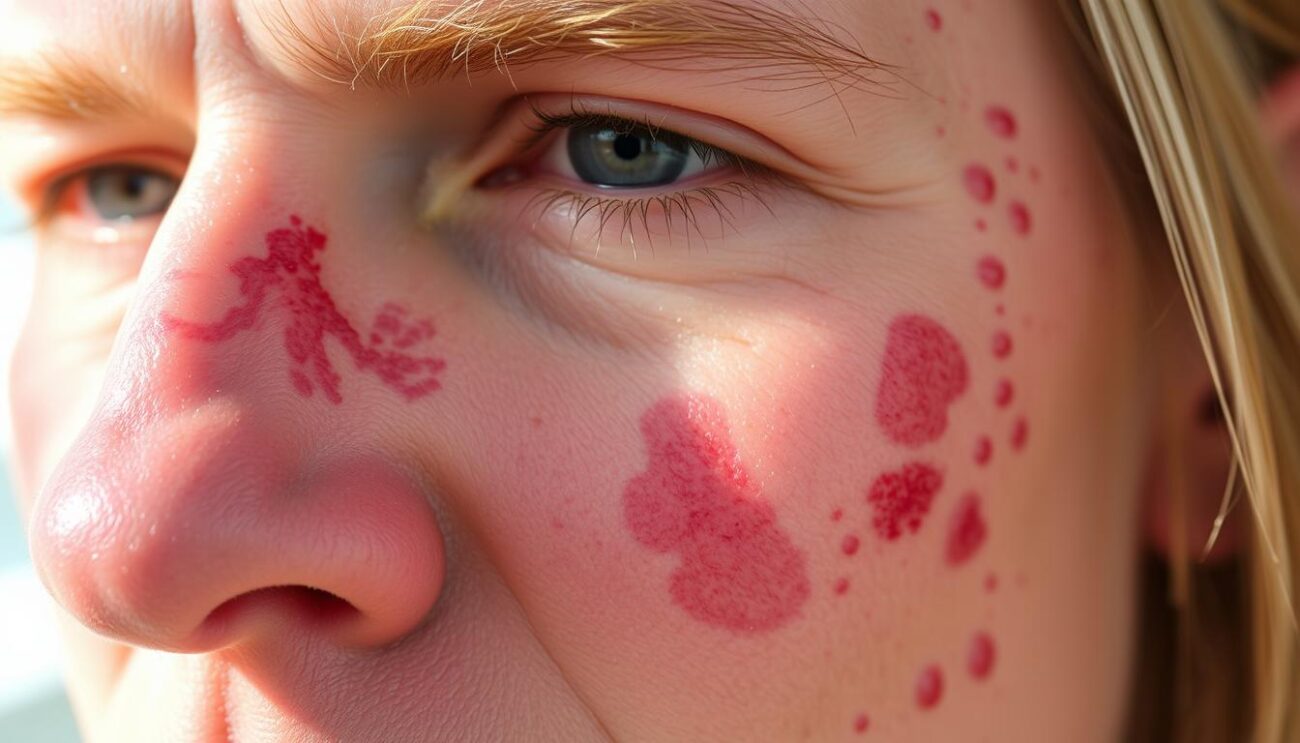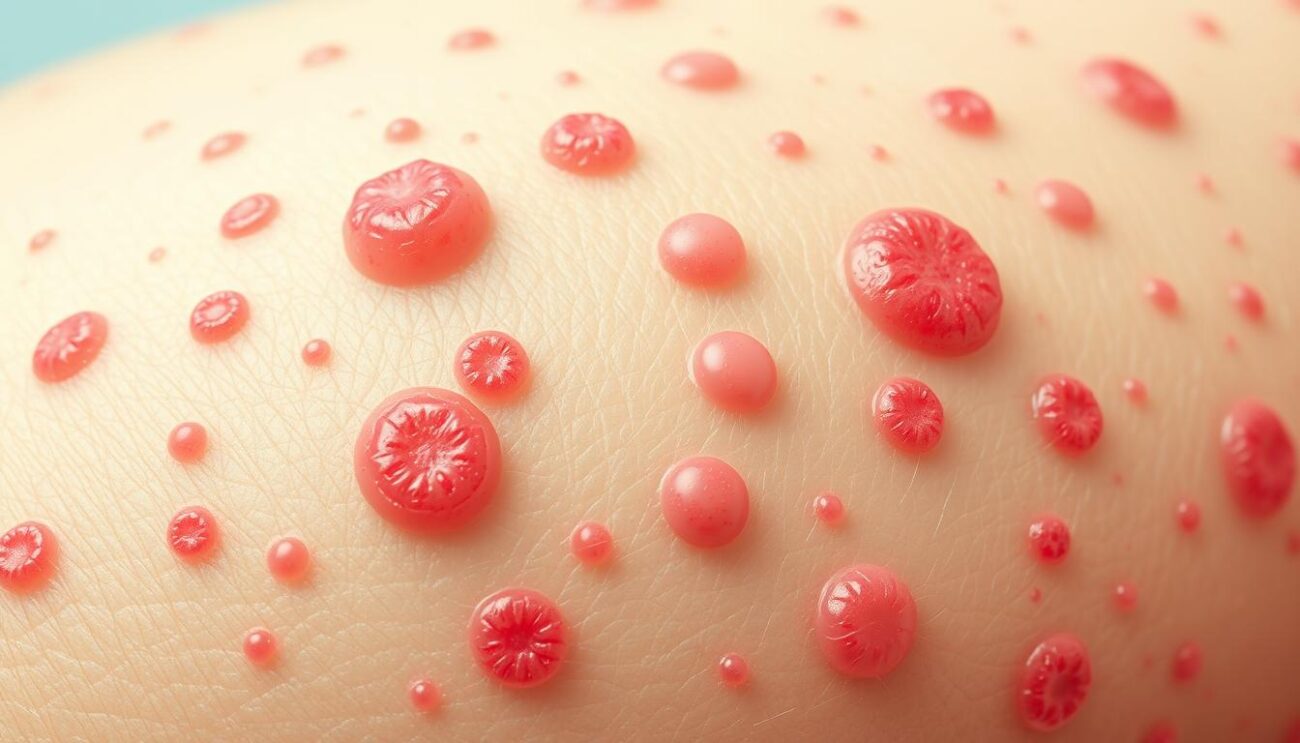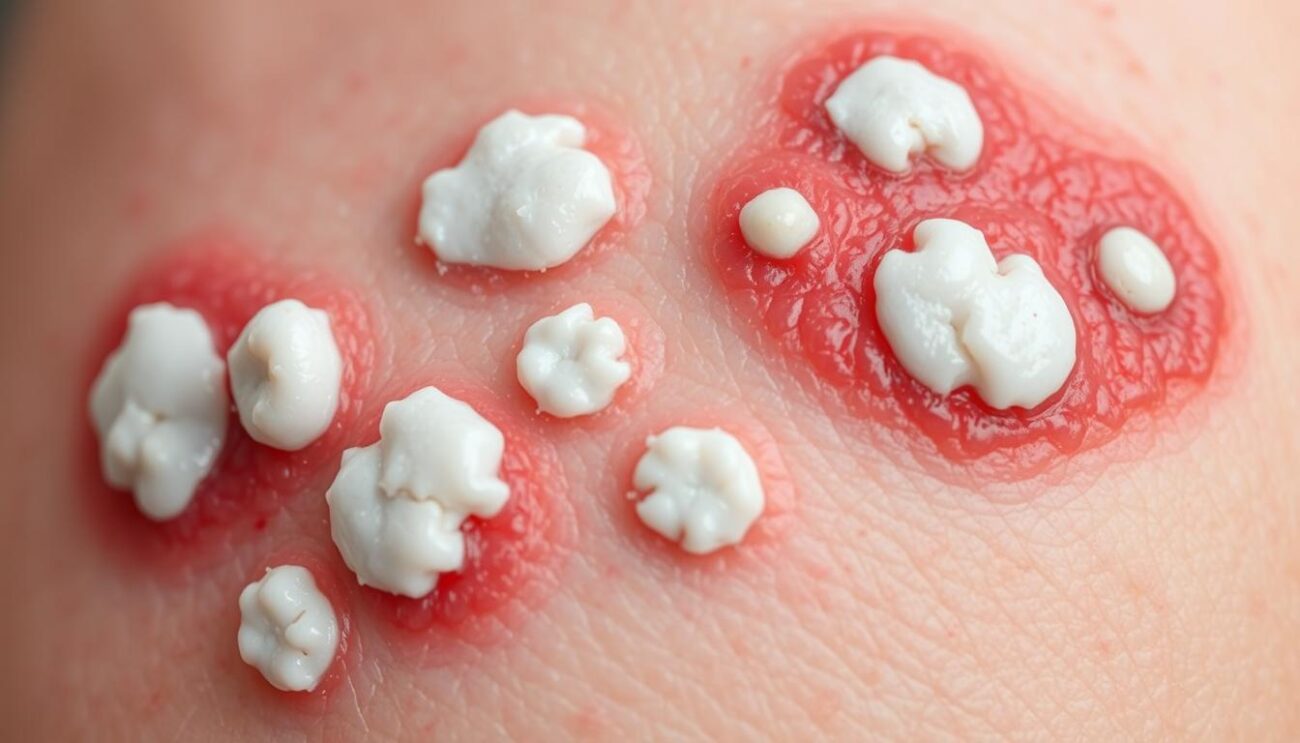Ever had facial redness, flaky skin, or an itchy scalp? You might have seborrheic dermatitis. This common skin issue can be managed. Let’s explore its causes, symptoms, and treatments for the face.
Key Takeaways
- Seborrheic dermatitis is a common, chronic skin condition that can affect the face, scalp, and other oily areas of the body.
- It is characterized by red, scaly, and sometimes itchy patches, and can be mistaken for other skin conditions like eczema or psoriasis.
- The condition is believed to be caused by an overgrowth of a naturally occurring yeast called Malassezia, which can trigger inflammation and irritation.
- Treatment options include medicated shampoos, topical creams or ointments, and in some cases, oral medications or light therapy.
- Maintaining a consistent skincare routine and managing stress can also help control the symptoms of seborrheic dermatitis.
What is Seborrheic Dermatitis of the Face?
Overview and Definition
Seborrheic dermatitis is a common type of eczema. It often shows up on the scalp but can also be found on the face. This condition causes oily, scaly patches with yellow or white scales.
It’s not contagious and doesn’t cause permanent hair loss. It’s a chronic condition that can be managed.
Prevalence and Risk Factors
Seborrheic dermatitis can hit anyone, but it’s more common in infants and adults between 30 and 60. It’s more common in males among adults and teens. Research shows 3-10 out of 100 people will get it at some point.
Having certain medical conditions can raise your risk. These include psoriasis, HIV, acne, rosacea, Parkinson’s disease, epilepsy, alcoholism, depression, eating disorders, and recovery from a stroke or heart attack.
| Condition | Increased Risk of Seborrheic Dermatitis |
|---|---|
| Psoriasis | Yes |
| HIV | Yes |
| Acne | Yes |
| Rosacea | Yes |
| Parkinson’s Disease | Yes |
| Epilepsy | Yes |
| Alcoholism | Yes |
| Depression | Yes |
| Eating Disorders | Yes |
| Recovery from Stroke or Heart Attack | Yes |
Causes and Triggers of Seborrheic Dermatitis of the Face
The exact cause of seborrheic dermatitis is still a mystery. But, it’s thought to be linked to an inflammatory reaction. This reaction happens when a type of yeast called Malassezia grows too much. This yeast is usually harmless but can cause a fungal infection when it overgrows.
Role of Malassezia Yeast
People with seborrheic dermatitis have too much Malassezia yeast on their skin. This yeast overgrowth leads to inflammation. This inflammation causes the skin changes seen in seborrheic dermatitis.
Environmental and Lifestyle Triggers
Other factors can also play a role in seborrheic dermatitis. These include:
- Stress and fatigue
- Changes in season, particularly colder, drier climates
- Use of harsh detergents or chemicals on the skin
- Certain medications
- Underlying medical conditions like psoriasis, HIV, Parkinson’s disease, and more
Seborrheic dermatitis often gets worse in the winter and better in the summer. This is especially true with more ultraviolet exposure. Stress and recovery from stressful life events are also common seborrheic dermatitis triggers.
“Seborrheic dermatitis is not contagious and is the result of environmental and genetic factors.”
Symptoms of Seborrheic Dermatitis of the Face
Seborrheic dermatitis is a chronic skin condition that can show different symptoms on the face. The symptoms can change based on age, skin color, and how bad the flare-up is.
Common symptoms of facial seborrheic dermatitis include:
- Flaky, scaly skin or dandruff
- Patchy white or yellow scales on the skin
- Reddish or discolored rashes
- Ring-shaped rashes
- Intense itchiness
The skin may look inflamed, crusty, or have sebum-filled lesions. People with darker skin, like African Americans, might get a more severe version. This version can cause distinctive ring-shaped rashes and skin color changes.
Knowing the different symptoms of seborrheic dermatitis is key to getting it right. Seeing a dermatologist is important. They can help figure out what symptoms you have and create a treatment plan just for you.
Diagnosis and When to See a Doctor
Doctors usually spot seborrheic dermatitis by looking at the skin. A dermatologist can make this diagnosis. If symptoms last more than two weeks or bother you a lot, you should visit a doctor. They can figure out why it’s happening and suggest the best treatment.
Seborrheic dermatitis makes the skin red, itchy, and scaly. This happens because of a yeast called Malassezia. It’s more common in men and often shows up in babies and again in teenagers and young adults.
When to See a Doctor
- If symptoms last more than two weeks
- If they’re really bad and affect your daily life
- To find out why it’s happening and get the right treatment
Diagnostic Process
When checking for seborrheic dermatitis, doctors will:
- Look at the affected skin
- Ask about your health history and what might trigger it
- Maybe do a skin biopsy to rule out other conditions
Getting a diagnosis early and treating it right is key. By going to the doctor, you can feel better and stop it from getting worse.
“Seborrheic dermatitis is a common, chronic inflammatory skin condition that primarily affects areas of the body with a high concentration of sebaceous (oil) glands, such as the face, scalp, and upper trunk.”
seborrheic dermatitis of the face
The look of seborrheic dermatitis changes a lot based on skin color. For those with brown or Black skin, the rash might look darker or lighter than the rest of the skin. On the other hand, people with white skin often see a reddish rash.
Those with darker skin, especially African Americans, might face a tougher version called petaloid seborrheic dermatitis. This type can cause ring-shaped rashes and clear skin discoloration. It can make the condition much harder to deal with.
It’s key to understand how seborrheic dermatitis looks different on various skin tones. This knowledge helps in getting the right diagnosis and treatment. Seeing a dermatologist who knows how to handle different skin types is very important.

“Seborrheic dermatitis can have a significant impact on individuals with skin of color, often leading to more severe and noticeable symptoms. Proper diagnosis and tailored treatment are crucial for managing this condition effectively.”
Treatment Options for Facial Seborrheic Dermatitis
Many people face the challenge of facial seborrheic dermatitis. It can be unsightly and hard to get rid of. Luckily, there are several treatments available. From simple over-the-counter remedies to stronger prescription drugs, the goal is to find what works best for you.
Over-the-Counter Treatments
For mild cases, over-the-counter options can help. These include shampoos and creams with pyrithione zinc, selenium sulfide, ketoconazole, tar, or salicylic acid. Brands like DermaZinc, Head & Shoulders, Selsun Blue, Nizoral, and Denorex Extra Strength are popular choices.
Prescription Medications
For more serious cases, doctors may prescribe stronger treatments. These can include creams or ointments with ciclopirox or ketoconazole. Sometimes, you might need to use topical corticosteroids or calcineurin inhibitors. Oral drugs like pimecrolimus or tacrolimus might also be recommended.
In 2023, the FDA approved a new treatment called Zoryve (foam 0.3%). It’s for seborrheic dermatitis in people 9 years old and up.
“Seborrheic dermatitis affects only 3 percent of the general population but may have an incidence as high as 85 percent in individuals with acquired immunodeficiency syndrome.”
By exploring different treatments and consulting with a doctor, you can find the best way to manage facial seborrheic dermatitis. This will help improve your skin’s health and reduce symptoms.
Self-Care and Lifestyle Management
Keeping up with a skincare routine can help control seborrheic dermatitis symptoms. Start by washing affected areas with a gentle, zinc-based cleanser every day. Then, apply a moisturizer to keep your skin hydrated. For your scalp, use a dandruff shampoo and hair products made for sensitive skin.
Healthy lifestyle habits also play a big role. Managing stress and getting enough sleep can improve your skin. These habits help prevent seborrheic dermatitis from getting worse.
Stress often triggers seborrheic dermatitis flare-ups. So, it’s key to find ways to manage stress. Try light exercises like yoga or walking, journaling, meditation, or spending time outdoors. A good self-care routine can greatly help manage seborrheic dermatitis.
Skincare Routine
- Wash affected areas daily with a gentle, zinc-containing cleanser
- Use a moisturizer after cleansing to keep skin hydrated
- Incorporate a dandruff shampoo and sensitive skin-friendly hair products for the scalp
Stress Management Techniques
- Practice light exercise like yoga or gentle walking
- Engage in journaling to address stress and negative emotions
- Develop a meditation or breathwork routine
- Spend time in nature to find inner calm
“Finding an enjoyable self-care routine that helps reduce stress can have a significant impact on managing seborrheic dermatitis.”
Seborrheic Dermatitis in Infants (Cradle Cap)
Seborrheic dermatitis is a common skin issue that shows up as cradle cap in babies. It looks like scaly, oily patches on a newborn’s scalp. About 10 percent of infants under one month get it, and by three months, it affects up to 70 percent.
The exact reasons for cradle cap in infants are still being studied. But, it’s usually not a big worry. It often goes away by itself within a few months, with or without treatment.
Seborrheic dermatitis can also show up on a baby’s face, diaper area, and body. In darker-skinned babies, it might look like light, scaly patches.
While it can sometimes get infected in the diaper area, most babies with it stay healthy. Using gentle oils like mineral oil or petroleum jelly can help get rid of the scaly crusts.
It’s worth noting that seborrheic dermatitis can come back as dandruff during puberty. But, the baby version is usually harmless and goes away by itself.
Complications and Misconceptions
Seborrheic dermatitis might be uncomfortable, but it’s not severe or life-threatening. Complications are rare, but can lead to skin infections in severe cases. It’s important to know that it doesn’t cause permanent hair loss or increase skin cancer risk.
Another misconception is that it’s contagious. But, it’s not a condition you can catch from someone else.
Studies show that seborrheic dermatitis often affects the scalp. It can also hit oily areas like the face, upper chest, and back. It’s common in babies, known as cradle cap, appearing in the first few months.
Two main factors cause seborrheic dermatitis: too much skin oil and a fungus called malassezia.
Things that might make you more likely to get seborrheic dermatitis include family history, being overweight, and poor skin care. Environmental pollution, being tired, and other skin or health issues also play a role. Washing your hair right, as advised by a doctor, and keeping your scalp clean can help manage it.
Many people think seborrheic dermatitis comes from poor hygiene or is contagious. But, it’s actually an inflammatory condition caused by genetics and environment. Proposed causes include an inflammatory skin reaction to Malassezia yeast, stress, climate changes, hormonal shifts, some medicines, and illnesses.
People with seborrheic dermatitis often get confused with rosacea. But, they are two different conditions. Getting a correct diagnosis from a dermatologist is key. While allergies aren’t the cause, harsh detergents and chemicals can make it worse.
“Seborrheic dermatitis is considered a chronic condition without an exact cause, impacting individuals of all ages, including babies who develop cradle cap.”
Seeking Professional Help
If you can’t manage seborrheic dermatitis symptoms with self-care and over-the-counter treatments, see a healthcare provider. A dermatologist can find the cause, check how bad it is, and create a treatment plan.
Seeing a dermatologist is key if symptoms are bad, don’t go away, or get in the way of daily life. They can give a detailed check-up and offer prescription meds or special treatments. They’ll find what’s causing it and make a plan just for you.
Seborrheic dermatitis can be ongoing. Self-care and over-the-counter treatments might help, but sometimes you need a doctor’s help to keep symptoms under control.
| When to See a Dermatologist for Seborrheic Dermatitis |
|---|
|
By getting professional help, you can work with a dermatologist to make a treatment plan just for you. This can help you control seborrheic dermatitis better, improving your skin and life quality.
“Proper diagnosis and treatment from a dermatologist are essential for managing seborrheic dermatitis effectively.”
Conclusion
Seborrheic dermatitis of the face is a common, chronic skin condition. It can cause discomfort and disrupt daily life. Understanding the causes, like Malassezia yeast and environmental triggers, is key.
Recognizing symptoms and seeking the right treatment is also important. This helps manage the condition effectively.
Many treatments are available, including over-the-counter and prescription medications. Topical antifungals, corticosteroids, and calcineurin inhibitors work well. A good skincare routine and stress management can also help.
Working with a healthcare professional is crucial. They can help create a personalized treatment plan. This leads to better skin health and a better quality of life.
Being proactive, consistent, and diligent is essential. This approach helps manage seborrheic dermatitis effectively.





